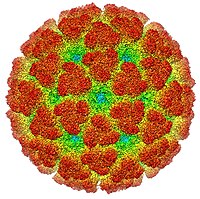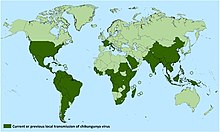Chikungunya virus
| Chikungunya virus | ||||||||||||||||||||
|---|---|---|---|---|---|---|---|---|---|---|---|---|---|---|---|---|---|---|---|---|

Cryo-electron microscopic reconstruction of a |
||||||||||||||||||||
| Systematics | ||||||||||||||||||||
|
||||||||||||||||||||
| Taxonomic characteristics | ||||||||||||||||||||
|
||||||||||||||||||||
| Scientific name | ||||||||||||||||||||
| Chikungunya virus | ||||||||||||||||||||
| Short name | ||||||||||||||||||||
| CHIKV | ||||||||||||||||||||
| Left | ||||||||||||||||||||
|
The Chikungunya virus (CHIKV) is an enveloped single (+) - strand RNA - virus [ss (+) RNA] and belongs to the genus Alphavirus of the family Togaviridae . In addition, the virus belongs to the group of arboviruses , i.e. it is transmitted through the bite of arthropods . The pathogen was discovered in 1953. The virus causes Chikungunya fever in humans .
features
The virion (virus particle) has a diameter of about 60 nm and is one of the smaller viruses.
In the past five years has been genome of several variants of the Chikungunya virus completely sequenced and compared analyzed . It is about 11,700 bases (1.2 × 10 4 ) in length and contains two genes : the gene of a non -structural polyprotein consisting of 2,474 amino acids and the gene of a structural polyprotein consisting of 1,248 amino acids . Both polyproteins are precursors and are split into several individual proteins after their synthesis . The single proteins nsP1 to nsP4 arise from the non-structural polyprotein, the single proteins C (structural protein of the virus capsid ), E1 to E3 (structural glycoproteins of the virus envelope ) and 6K arise from the structural polyprotein . The protein nsP4 presumably takes on the function of an RNA polymerase and thus serves to replicate the virus genome .
The virus and its variants are sensitive to heat (over 58 ° C), dehydration, soap and disinfectants .
Occurrence
According to the different geographical distribution of the virus, it is now divided into five different variants, which differ genetically : a West African, a Central African, an East and South African, an Indian Ocean and an Asian.
A strain first appeared in southern Europe in 2008. It is speculated that the virus could soon also spread to North America.
An increased incidence of chikungunya fever was reported in 2014 in particular from the following countries or areas: Senegal , Gambia , Guinea , Tanzania , from the south and southeast of Asia ( Philippines , Malaysia , Thailand , Cambodia , Myanmar , Sri Lanka , India , Indonesia , Saudi -Arabia ) as well as from some Caribbean islands and South America since the end of 2013.
transmission
The chikungunya virus can theoretically by the bite of various mosquitoes of the genera malaria mosquitoes ( Anopheles ), Aedes , Culex and Mansonia be transferred. So far (as are unique carriers vectors ), the yellow fever mosquito Aedes aegypti (since 2004 Stegomyia aegypti ) and originally from East Asia coming Asian tiger mosquito , Aedes albopictus (since 2004 Stegomyia albopicta ) demonstrated. A point mutation in an amino acid resulted in a new strain (CHIKV 06.21), which has a higher pathogenicity and thus almost twice as high a viral load in the tiger mosquito as non-mutated strains. This is due to the virus' better chances of survival in the mosquito's digestive system. This very aggressive mosquito, only two to ten millimeters in size, black and white striped, which bites during the day and sometimes even through clothing, has spread worldwide and transmits dengue fever and yellow fever in addition to chikungunya fever , West Nile fever and other diseases. This mosquito species is now also found in southern Europe (mainly in the hot summer months), but so far no specimens infected with the Chikungunya virus have been found here.
Consequences of infection
The clinical picture of the Chikungunya fever triggered by this virus and the possible transmission cycles (human-human = urban cycle or animal-human = sylvatic cycle) are partly similar to dengue fever and yellow fever . The chikungunya virus is closely related to the O'nyong-Nyong fever -causing O'nyong-Nyong virus related (ONNV). Monkeys and rodents have so far been identified as reservoir hosts .
Historical
In 1986 a report about the American bioweapons laboratory at Fort Detrick caused a stir. In 1981 two liters with the Chikungunya virus were stolen. The fact came to light through indiscretion by a former employee.
Reporting requirement
In Germany, direct or indirect evidence is subject to notification by name in accordance with Section 7 of the Infection Protection Act (IfSG) if the evidence indicates an acute infection. The obligation to notify primarily concerns the management of laboratories ( § 8 IfSG).
In Switzerland, the positive laboratory analytical finding for laboratories is notifiable and that after the Epidemics Act (EpG) in connection with the epidemic Regulation and Annex 3 of the Regulation of EDI on the reporting of observations of communicable diseases of man .
Individual evidence
- ↑ ICTV Master Species List 2018b v1 MSL # 34, Feb. 2019
- ↑ a b c d ICTV: ICTV Master Species List 2019.v1 , New MSL including all taxa updates since the 2018b release, March 2020 (MSL # 35)
- ↑ Isabelle Schuffenecker et al .: Genome Microevolution of Chikungunya Viruses Causing the Indian Ocean Outbreak. In: PLoS Medicine . Vol. 3, No. 7, 2006, pp. 1058-1070, DOI: 10.1371 / journal.pmed.0030263 , ISSN 1549-1277 .
- ↑ Public Health Agency of Canada: Pathogen Safety Data Sheet - Chikungunya virus (Eng.)
- ^ Philippe Parola et al .: Novel Chikungunya Virus Variant in Travelers Returning from Indian Ocean Islands. In: Emerging Infectious Diseases . Vol. 12, No. 10, 2006, pp. 1493-1499, ISSN 1080-6040 ( PDF; 363 kB ).
- ↑ Karge, Desiree: "Bloss not let sting", Bild der Wissenschaften, 11/2008, p. 110
- ↑ Robert Koch Institute (Ed.): Infection epidemiological yearbook of reportable diseases for 2014, p. 214, data status: March 1, 2015, full text (PDF)
- ↑ Prasanna N. Yergolkar et al .: Chikungunya Outbreaks Caused by African Genotype, India. In: Emerging Infectious Diseases . Vol. 12, No. 10, 2006, pp. 1580–1583, ISSN 1080-6040 ( PDF; 178 kB )
- ↑ Patrick Hochedez et al .: Chikungunya Infection in Travelers . In: Emerging Infectious Diseases . Vol. 12, No. 10, 2006, pp. 1565–1567, ISSN 1080-6040 ( PDF; 128 kB )
- ↑ http://www.virologyj.com/content/5/1/33 Eric Leroy et al .: Chikungunya virus adapts to tiger mosquito via evolutionary convergence: a sign of things to come? Virology Journal 2008, 5:33, doi : 10.1186 / 1743-422X-5-33 .
- ↑ Vazeille M, Moutailler S, Coudrier D, Rousseaux C, Khun H et al. (2007) Two Chikungunya Isolates from the Outbreak of La Reunion (Indian Ocean) Exhibit Different Patterns of Infection in the Mosquito, Aedes albopictus. PLoS ONE 2 (11): e1168 doi : 10.1371 / journal.pone.0001168 [1]
- ↑ Dana L. Vanlandingham et al. : Differential infectivities of o'nyong-nyong and chikungunya virus isolates in Anopheles gambiae and Aedes aegypti mosquitoes . In: Am J Trop Med Hyg . Vol. 72, No. 5, 2005, pp. 616–621, ISSN 0002-9637 (in the web archive)
- ↑ Robert Koch Institute: Epidemiological Bulletin No. 10, March 10, 2006 ( PDF; 117 kB )
- ↑ Dangerous viruses are gone . In: Frankfurter Rundschau , September 25, 1986

